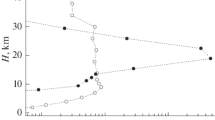Abstract
A computationally efficient and rigorous thermodynamic model that predicts the physical state and composition of inorganic atmospheric aerosol is presented. One of the main features of the model is the implementation of mutual deliquescence of multicomponent salt particles, which lowers the deliquescence point of the aerosol phase.
The model is used to examine the behavior of four types of tropospheric aerosol (marine, urban, remote continental and non-urban continental), and the results are compared with the predictions of two other models currently in use. The results of all three models were generally in good agreement. Differences were found primarily in the mutual deliquescence humidity regions, where the new model predicted the existence of water, and the other two did not. Differences in the behavior (speciation and water absorbing properties) between the aerosol types are pointed out. The new model also needed considerably less CPU time, and always shows stability and robust convergence.
Similar content being viewed by others
References
Allen, A. G., Harrison, R. M., Erisman, J. W. (1989) Field measurements of the dissociation of ammonium nitrate and ammonium chloride aerosols. Atmos. Environ. 23, 1591-1599.
Bassett, M., and Seinfeld, J. H. (1983) Atmospheric equilibrium model of sulfate and nitrate aerosols. Atmos. Environ. 17, 2237-2252.
Bassett, M., and Seinfeld, J. H. (1984) Atmospheric equilibrium model of sulfate and nitrate aerosols-II. Particle size analysis. Atmos. Environ. 18, 1163-1170.
Bromley, L. A. (1973) Thermodynamic properties of strong electrolytes in aqueous solutions. AIChE J. 19, 313-320.
Charlson, R. J., Lovelock, J. E., Andreae, M. O., and Warren, S. G. (1987) Oceanic phytoplankton, atmospheric sulphur, cloud albedo and climate. Nature 326, 655-661.
Denbigh, K. (1981) The principles of chemical equilibrium.Fourth Ed., Cambridge University Press, Cambridge.
Deepak, A. and Gali, G. (1991) The international global aerosol program (IGAP) plan.Deepak Publishing, Hampton, Virginia.
Fitzgerald, J. W. (1991) Marine aerosols: A review. Atmos. Environ. 25A, 533-545.
Heintzenberg, J. (1989) Fine particles in the global troposphere, A review. Tellus, 41B, 149-160.
Hildemann, L. M., Russell, A. G. and Cass, G. R. (1984) Ammonia and nitric acid concentrations in equilibrium with atmospheric aerosols: Experiment vs. Theory. Atmos. Environ. 18, 1737-1750.
Jacobson, M. Z., Tabazadeh, A., Turco, R. P. (1996) Simulating equilibrium within aerosols and nonequilibrium between gases and aerosols. J. Geophys. Res., 101, 9079-9091.
Kim, Y. P., Seinfeld, J. H. and Saxena, P. (1993) Atmopsheric gas-aerosol equilibrium I. Thermodynamic model. Aerosol Sci. Technol., 19, 157-181.
Kim, Y. P., Seinfeld, J. H. and Saxena, P. (1993b) Atmopsheric gas-aerosol equilibrium II. Analysis of common approximations and activity coefficient methods. Aerosol Sci. Technol. 19, 182-198.
Kusik, C. L. and Meissner, H. P. (1978) Electrolyte activity coefficients in inorganic processing. AIChE Symp. Series 173, 14-20.
Meng, Z. and Seinfeld, J. H. (1996) Time scales to achieve atmospheric gas-aerosol equilibrium for volatile species., Atmos. Environ. 30, 2889-2900.
Pandis, S. N., Wexler, A. S., Seinfeld, J. H. (1995) Dynamics of tropospheric aerosols. J. Phys. Chem., 99, 9646-9659.
Pilinis, C. and Seinfeld, J. H. (1987) Continued development of a general equilibrium model for inorganic multicomponent atmospheric aerosols. Atmos. Environ. 21, 2453-2466.
Pilinis, C., Pandis, S. N., Seinfeld, J. H. (1995) Sensitivity of direct climate forcing by atmospheric aerosols to aerosols size and composition. J. Geophys. Res., 100, 18739-18754.
Pitzer, K. S. and Mayorga, G. (1973) Thermodynamics of electrolytes - II. Activity and osmotic coefficients for strong electrolytes with one or both ions univalent. J. Phys. Chem., 77, 2300-2308.
Potukuchi, S. and Wexler, A. S. (1995a) Identifying solid-aqueous phase transitions in atmospheric aerosols - I. Neutral-acidity solutions. Atmos. Environ., 29, 1663-1676.
Potukuchi, S. and Wexler, A. S. (1995b) Identifying solid-aqueous phase transitions in atmospheric aerosols - II. Acidic solutions. Atmos. Environ. 29, 3357-3364.
Quinn, P. K., Asher, W. E. and Charlson, R. J. (1992) Equilibria of the marine multiphase ammonia system. J. Atmos. Chem., 14, 11-30.
Robinson, R. A. and Stokes, R. H. (1965) Electrolyte solutions.Second Ed., Butterworths, London.
Russell, L. M., Pandis, S. N., Seinfeld, J. H. (1994) Aerosol production and growth in the marine boundary layer. J. Geophys. Res., 99, 20989-21003.
Saxena, P. and Peterson, T. W. (1981) Thermodynamics of multicomponent electrolytic aerosols. J. Coll. Interf. Sci. 79, 496-510.
Saxena, P., Hudischewsky, A. B., Seigneur, C., Seinfeld, J. H. (1986) A comparative study of equilibrium approaches to the chemical characterization of secondary aerosols. Atmos. Environ., 20, 1471-1483.
Saxena, P., Mueller, P. K., Kim, Y. P., Seinfeld, J. H., Koutrakis, P. (1993) Coupling thermodynamic theory with measurments to characterize acidity of atmospheric aerosols. Aeros. Sci. Tech., 19, 279-293.
Tang, I. N. and Munkelwitz, H. R. (1993) Composition and temperature dependance of the deliquescence properties of hygroscopic aerosols. Atmos. Environ., 27A, 467-473.
Wagman, D. D., Evans, W. H., Parker, V. B., Schumm, R. H., Harlow, I., Bailey, S. M., Churney, K. L., Nuttall, R. L. (1982) The NBS tables of chemical thermodynamic properties. J. Phys. Chem. Ref. Data.Vol. 11, Suppl. 2
Wexler, A. S. and Seinfeld, J. H. (1991) Second-generation inorganic aerosol model. Atmos. Environ. 25A, 2731-2748.
Author information
Authors and Affiliations
Rights and permissions
About this article
Cite this article
Nenes, A., Pandis, S.N. & Pilinis, C. ISORROPIA: A New Thermodynamic Equilibrium Model for Multiphase Multicomponent Inorganic Aerosols. Aquatic Geochemistry 4, 123–152 (1998). https://doi.org/10.1023/A:1009604003981
Issue Date:
DOI: https://doi.org/10.1023/A:1009604003981




